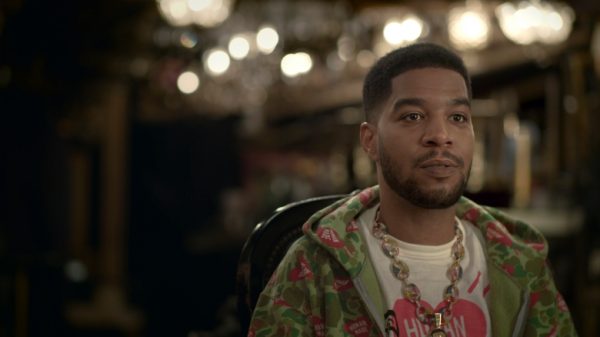Words by: Elaina Bernstein
Scott Mescudi (aka Kid Cudi) has been a voice for the voiceless– an ethereal, transcendent, voice, that is. Through his music, Cudi has taken us into the deepest, darkest depths of his brain, making us feel a little less alone in our OWN feelings of lostness or hopelessness; Cudi’s ability to majestically marry //these// introspective lyrics with magical melodies is his superpower. But what Cudi has always wanted us to understand, however, is that he is human. In the movie A Man Named Scott, we are able to see what Cudi has been singing about for his entire career. Through his slew of genre-bending albums, we’ve heard what it sounds like in his brain. Now we get to see what it looks like up there.
In true Cudi fashion, the film defies the constraints of genre. Just as Cudi strays from the historical confines of the “hip hop” genre in his music, A Man Named Scott does not hold itself to the rather restrictive (and oftentimes boring) “documentary” style of storytelling standards. “If I got caught up in expectations and what people wanted from me, Man on the Moon would not have sounded how it sounded,” the rapper says in the film. It is clear that the only expectations that influenced this film were his own.
The first half of the film follows Cudi’s 2008 skyrocket to fame with the success of his first mixtape, A Kid Named Cudi, the viral single “Day n’ Nite,” and his heavily-anticipated first album: Man on the Moon: The End of the Day. The second half of the film follows Cudi through his global success and stardom, as he made album after album, each with more groundbreaking production techniques than the last … yet his external professional peak simultaneously aligns with his internal rock bottom. In the first half, Cudi, wearing designer clothes from head to toe, sits in an elaborately-decorated room, adorned with gold accessories. In the second half, Cudi sits in an empty, white-walled room, wearing all black, his silhouette constantly mingling with the shadows behind him.

And Cudi is honest with us, explaining even the darkest of lyrics (“I was close to go and trying some coke, And a happy ending would be slitting my throat”). To hear him reflect on his own work and creative process in such an authentic way was what Cudi fans were missing all along. And A Man Named Scott gives it to us.
Though Cudi’s self-reflection and self-criticism define the genuine tone upheld throughout the film, the most fascinating part of the film, however, is the visual element; everything that is explained through narration, song lyrics, or talking heads is also expressed through captivating visual sequences as well. As Cudi narrates his relationship with the ominous nature of the solar system, psychedelic imagery of astronauts and planets cloud the screen, or when he describes his personal mission to continue “stepping out of his box,” we watch as a dancer contorts herself gracefully inside a glass box.
These visual sequences become more complex, with an entire supplemental cast of background dancers who perform lyrical interpretations or ensemble dance numbers to the songs that Cudi is discussing. In the second half of the film, the visual aspect of the film grows more significant. Jaden Smith plays the role of a troubled Cudi, and dimly-lit shots of Smith (as Cudi) are interspersed within the narration and footage.
There couldn’t have been a more ideal and diverse range of additional sources, ranging from rappers like Kanye West and Schoolboy Q to big-name producers including Jeff Bhasker, Dr. Candice Norcott, a clinical psychiatrist, both Jaden and Willow Smith, plus two other actors and close companions of Cudi’s, Timothee Chalamet and Shia Labeouf. Each speaker is introduced with a screen of neon titles and descriptions projected behind them; not only does this provide us with key background about the speaker, but in true Cudi fashion, does so in a not-boring and colorful way.
We also see ourselves in the film, regular Cudi fans of all ages. The fans praise Cudi’s ability to normalize the feeling of “lostness” and vocalize his emotions in a way that no artist has been able to do before. “Kid Cudi saved my life,” is recited by a multitude of these fans– Travis Scott among them.
Cudi has always been effortlessly able to walk between the worlds of the genre, inhabiting the intersection. He’s a rapper, but also a rockstar. Yet this film shows a new duality to Cudi’s persona: he is successful, but he is filled with deep sorrow. He is a voice for the voiceless, yet he often feels like “a fraud”, explaining that people look up to him but that he’s “just not a happy person.” He is human.
We Cudi fans are very familiar with the impact Cudi has left on the world, but it is in this film that we, for the first time, get to see the impact the world has had on Cudi– no matter how hard it may be to watch or listen to.
The film ends on a refreshing high note after the omnipresent darkness of the second half. West and Cudi are performing together after Cudi’s 2019 relapse. They have elevated hundreds of yards above the ecstatic crowd, standing in a clear, plexiglass box filled with radiant orange light exuding from all around. “Reborn” by Kids See Ghosts (Cudi and West’s collaboration project) plays.
I’m so reborn, I’m movin’ forward…
Keep movin’ forward… keep movin’ forward…
“I just have no desire to make any more dark records. I don’t want to put more of that out in the world. I hope people got it when I put it out, but that chapter is done.”
—
Originally from Las Vegas, Elaina Bernstein is a graduate student at New York University earning her Masters in Magazine and Digital Journalism.
You can follow her on Twitter and Instagram.
